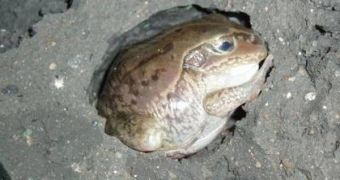Cyclorana alboguttata (the burrowing frog) is one of the least known animals in the world. And certainly the fact that it's a frog doesn't help it all that much either. However, most of you would be surprised to learn that the vertebrate can do only what bacteria have been known to be capable of, which is survive for years on end without any source of water or food. And while the microorganisms feed on the natural decay of uranium, or on pure hydrogen, the frog consumes nothing.
The most amazing feat about this frog is that it can minimize its cellular metabolism to such a low point, that it essentially never runs out of the limited amount of energy it has in the first place. Exactly how this is done has left researchers scratching their heads since the frog's ability was first discovered. However, the men in white coats figured out that such a level of energy preservation could eventually help people get rid of such diseases as obesity. The find belongs to Ms. Sara Kayes, who will be presenting it today in Glasgow, at the annual meeting of the Society of Experimental Biology.
The researcher has understood, upon her studying of the wondrous frog, that the phenomenon largely responsible for its lack of desire to die is something called mitochondrial coupling. This bizarre and counter-intuitive process starts when the animal enters its sleep phase. Oddly enough, it's only at that time that the mitochondria inside the cell, which are essentially the power plants that drive all living organisms, decide they should operate at optimum efficiency, and do so flawlessly.
This translates directly into the fact that the cells make use of the limited power reserves they have so efficiently, that they basically allow for years and years of vegetation in some mud hole, until the right conditions are met outside. It's at that time that the zombified frog awakes from its slumber, and goes about replenishing its energy. Also, when it wakes up, the mitochondria revert to being less efficient, and start burning power at an alarming rate.
However, the frog is blessed by the fact that it has cold blood. This means that its body does not have to constantly fight to keep a minimum temperature inside the organism, such as our mitochondria do. Humans are known to live ideally at a 36-degree-Celsius temperature. Any increase, and it's a sign that something is wrong, and that our bodies are doing something extra, such as bolstering the immune system to fight off a bacterial attack.
Another reason why Cyclorana alboguttata endures the way it does is the fact that its slumber is significantly different from that of, say, hibernating bears. In other words, while the large mammals tend to spontaneously wake up during their sleep, and then immediately fall back in hibernation, the frog does not do this, as it would destroy the efficiency of its mitochondria. Rather, it sleeps for a few years, and then wakes up, in search for something to eat and drink.

 14 DAY TRIAL //
14 DAY TRIAL //